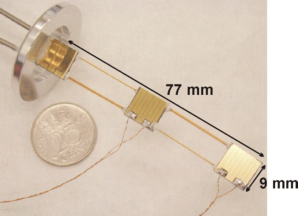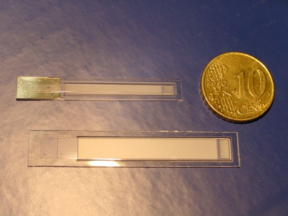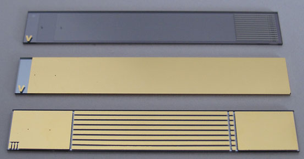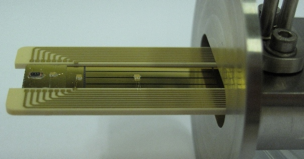This research is financially supported by the Dutch Technology Foundation (STW) and the European Space Agency (ESA)
There is a growing need for miniature cryogenic coolers for cooling a wide variety of electronic devices, including low-noise amplifiers (LNAs), optical detectors and semiconducting and superconducting circuits. For these applications, the cooler should be small, low cost, low interference and have a very long life-time. Joule-Thomson (JT) coolers are excellent for this, because they do not contain moving parts and therefore can be scaled to very small sizes. When combined with a sorption compressor, a closed-cycle cooler without containing moving parts can be obtained. Such a cooling system is virtually vibration-free and potentially has a long life-time.

First MEMS-cooler of Burger et al.

Right: micromachined Joule-Thomson coolers of Lerou et al.
At the University of Twente, the miniaturization of Joule-Thomson (JT) coolers is investigated since 1995. Burger et al. started with exploring the possibility to fabricate JT cooler parts by means of micro-electro-mechanical-systems (MEMS) technology. They combined a miniature JT cold stage with a sorption compressor and in that way produced a closed-cycle cooler system. The cold stage consisted of a tube-in-tube heat exchanger made of glass capillaries glued to a micromachined silicon evaporator volume (Fig. ). The cooler was operated with ethylene and delivered a cooling capacity of 200 mW at 170 K, while it was precooled to 238 K with a thermoelectric cooler.
In a follow-up project, Lerou et al. successfully developed and tested micromachined JT cold stages that were fabricated by MEMS-technology only (see figure above). These cold stages consisted of a stack of three glass wafers. The high and low-pressure lines were placed on top of one another; etched in the top and middle wafer as rectangular channels with supporting pillars. A highly reflective thin layer of gold was sputtered on the outer surface to minimize the parasitic heat loss due to radiation. Operated with nitrogen gas, net cooling powers of 10 to 20 mW at 100 K were obtained. The cold stages were optimized for maximum performance in combination with minimum size by minimizing the entropy generation. The smallest cold stage had dimensions of 30.0 x 2.2 x 0.7 mm3.
At present, two follow-up projects are running. In the first project, two-stage JT cold stages are under development that are able to reach temperatures of about 30 K. Furthermore, a vibration-free microcooler system will be built and tested consisting of a JT cold stage integrated with a sorption compressor. Also, the fabrication of a small vacuum chamber with a long life-time (about 5 years) is investigated as well as the prevention of clogging of these microcoolers due to the deposition of small amounts of water vapor. In a utilization pilot, a demonstrator cooling system will be made that cools a low-noise amplifier to about 100 K for the Square Kilometer Array (SKA) project.

New generation of micromachined Joule-Thomson coolers.

A microcooler mounted in a flange for characterization measurements.
In the second project, the utilization of single-stage micromachined JT coolers for cooling small detector systems in future space missions is investigated. The aim is to have multiple miniature JT cold stages, each cooling a detector array, distributed over a satellite, remote from a single compressor used to drive the set of micro cold stages. Topics of this research are the interfacing between micro cold stages and optical detector arrays, the characterization of micro cold stages cooling detector arrays and building a demonstrator cooling system with multiple cold stages driven by a single compressor.
Further reading
- Distributed Joule-Thomson microcooling for optical detectors in space
J.H. Derking, PhD thesis, University of Twente, (2011),
<https://research.utwente.nl/en/publications/distributed-joule-thomson-microcooling-for-optical-detectors-in-s> - Progress in Joule-Thomson microcooling at the University of Twente
J.H. Derking et al., Cryocoolers 16, 463-471 (2010) - Characterization of micromachined cryogenic coolers
P.P.P.M Lerou et al., J. Micromech. Microeng. 17, 1956-1960 (2007) - Fabrication of a micro cryogenic cold stage using MEMS-technology
P.P.P.M Lerou et al., J. Micromech. Microeng. 16, 1919-1925 (2006) - Insight into clogging of MEMS based micro cryogenic coolers
P.P.P.M Lerou et al., Appl. Phys. Lett. 90, 064102 (2007) - Optimization of counterflow heat exchanger geometry through minimization of entropy generation
P.P.P.M. Lerou et al., Cryogenics 45, 659-669 (2005) - Micromachined Joule-Thomson cryocooler
P.P.P.M Lerou, PhD thesis, University of Twente, (2007),
<https://research.utwente.nl/en/publications/micromachined-joule-thomson-cryocooler> - 165 K microcooler operating with a sorption compressor and a micromachined cold stage
J.F. Burger et al., Cryocoolers 11, 551-560 (2001) - Cryogenic microcooling, a micromachined cold stage operating with a sorption compressor in a vapor compression cycle
J.F. Burger, PhD thesis, University of Twente, (2001),
<https://research.utwente.nl/en/publications/cryogenic-microcooling-a-micromachined-cold-stage-operating-with->
